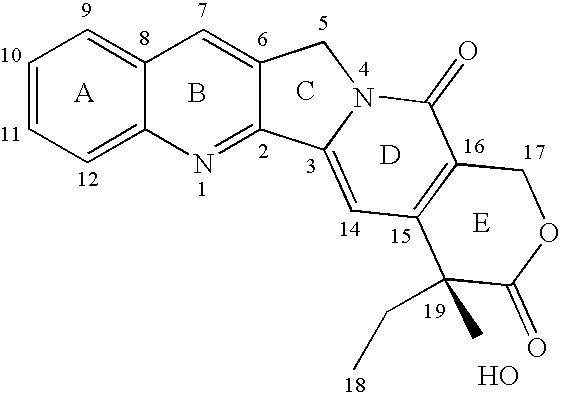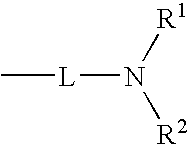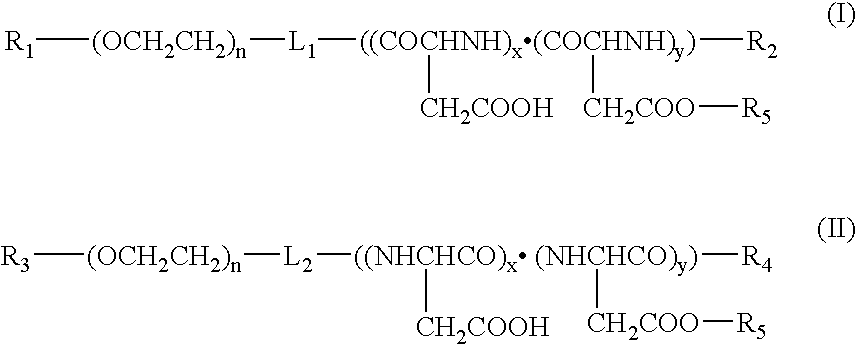Composition containing nanoparticles containing water-soluble basic drug encpsulated therein
- Summary
- Abstract
- Description
- Claims
- Application Information
AI Technical Summary
Benefits of technology
Problems solved by technology
Method used
Image
Examples
example 2
(Use of a Different Lot Block Copolymer from Example 1)
[0033] Polyethylene glycol (molecular weight: 12000)—co-poly(benzyl-L-aspartate) (degree of polymerization of aspartic acid: 50) (esterification rate: 100%) (hereinafter referred to as PEG-PBLA 12-50) was used as block copolymer. 50 mg of PEG-PBLA 12-50, 1 mg of TPT and 20 mg of PLA-20000 were put into a 9 mL screwed tube bottle, and were then dissolved in 2 mL of dichloromethane. The resultant solution was then dried and solidified with nitrogen blowing, and a film-like matter was obtained. To the film-like matter, 3 mL of water was added, and the resultant mixture was stirred vigorously for a whole day and night at 4° C. The mixture was thereafter subjected to sonification for five minutes, and, then, large particles and extraneous matters were filtered out with a membrane having a pore size of 0.8 μm, and, thus, TPT-containing micellar nanoparticles were prepared. Furthermore, unencapsulated drug was removed by Amicon Ultra...
example 3
[0042] Polyethylene glycol (molecular weight: 12000)—co-poly(benzyl-L-aspartate) (degree of polymerization of aspartic acid: 50) (hereinafter referred to as PEG-PBLA 12-50) was used as block copolymer. 50 mg of PEG-PBLA 12-50, 1 mg of TPT and 20 mg of PLA-20000 were put into a 9 mL screwed tube bottle, and were then dissolved in 1 mL of acetone. The resultant solution was then dried and solidified with nitrogen blowing, and a film-like matter was obtained. To the film-like matter, 3 mL of water was added, and the resultant mixture was stirred vigorously for a whole day and night at 4° C. The mixture was thereafter subjected to sonification for five minutes, and, then, large particles and extraneous matters were filtered out with a membrane having a pore size of 0.8 μm, and, thus, TPT-containing micellar nanoparticles were prepared. Furthermore, unencapsulated drug was removed by Amicon Ultra, an ultrafiltration membrane (MWCO: 100,000).
[0043] Encapsulating rate was measured with an...
example 4
[0047] Polyethylene glycol (molecular weight: 12000)—co-poly(octyl-L-aspartate) (degree of polymerization of aspartic acid: 25) (hereinafter referred to as PEG-PLAC8 12-25) was used. 20 mg of PEG-PLAC8 12-25, 1 mg of TRH and 20 mg of PLA-20000 were put into a 9 mL screwed tube bottle, and were then dissolved in a mixture of 1 mL of acetone and 80 μL of methanol. The resultant solution was then dried and solidified with nitrogen blowing, and a film-like matter was obtained. To the film-like matter, 3 mL of water was added, and the resultant mixture was stirred vigorously for a whole day and night at 4° C. The mixture was thereafter subjected to sonification for five minutes, and, thus, TRH-containing nanocapsules were prepared.
[0048] Encapsulating rate was measured with an ultrafiltration membrane (Microcon YM-100; MWCO: 100,000). 100 μL of sample was set in Microcon, and was then centrifuged for five minutes at 4° C., 10000 rpm, to give a filtrate. The amount of TRH in the sample (...
PUM
| Property | Measurement | Unit |
|---|---|---|
| Solubility (mass) | aaaaa | aaaaa |
| Hydrophilicity | aaaaa | aaaaa |
| Biodegradability | aaaaa | aaaaa |
Abstract
Description
Claims
Application Information
 Login to View More
Login to View More - R&D
- Intellectual Property
- Life Sciences
- Materials
- Tech Scout
- Unparalleled Data Quality
- Higher Quality Content
- 60% Fewer Hallucinations
Browse by: Latest US Patents, China's latest patents, Technical Efficacy Thesaurus, Application Domain, Technology Topic, Popular Technical Reports.
© 2025 PatSnap. All rights reserved.Legal|Privacy policy|Modern Slavery Act Transparency Statement|Sitemap|About US| Contact US: help@patsnap.com



